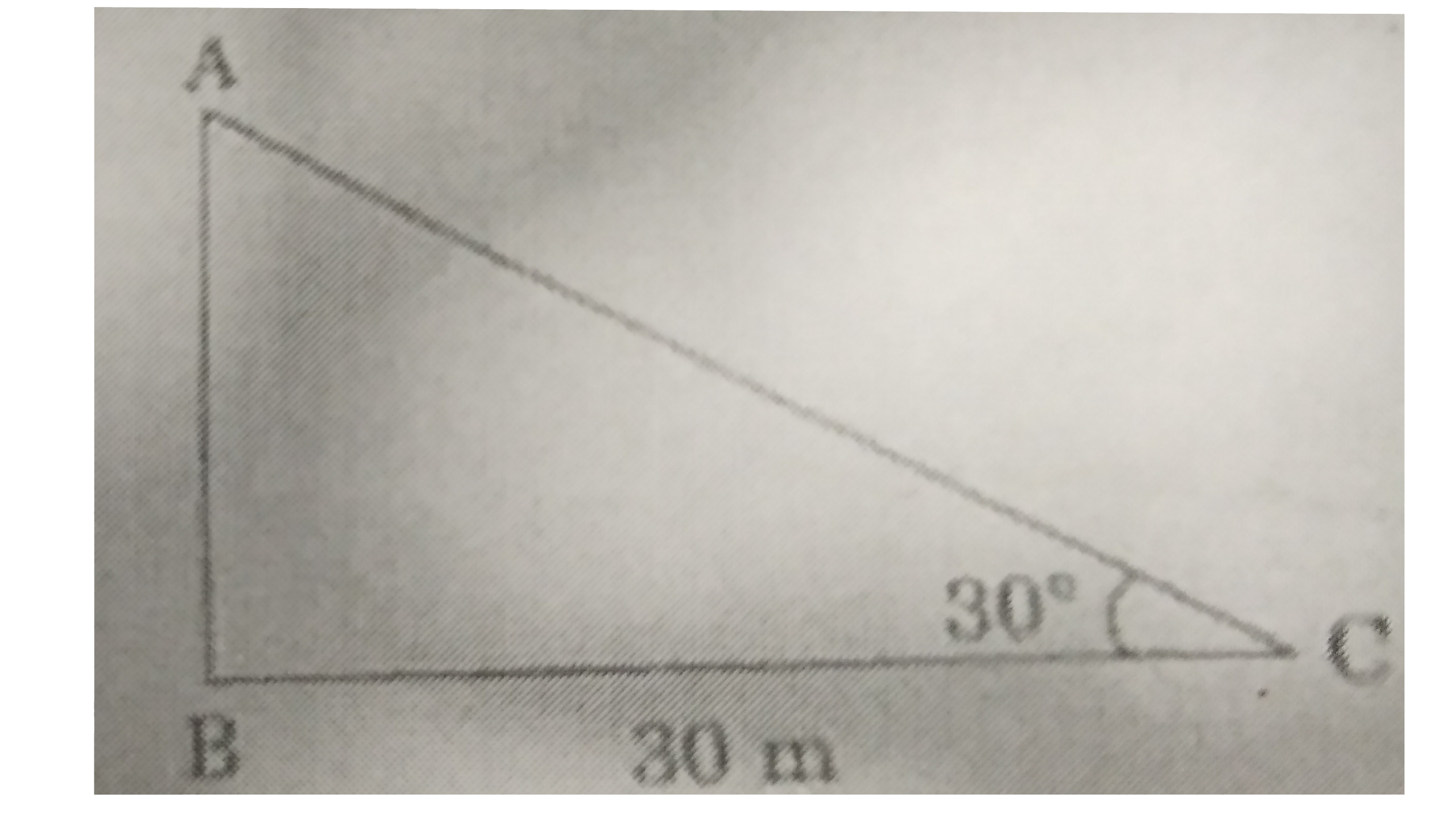The angle of elevation of the top of a tower at any point on the ground is and moving 20 metres towards the tower it becomes . The height of the tower is
10 m
m
m
none of these
The correct Answer is:B
To solve the problem, we will use trigonometric ratios. Let's break down the solution step by step.
Step 1: Understand the Problem
We have a tower (AB) of height H. The angle of elevation from a point P on the ground to the top of the tower is 30∘. When we move 20 meters towards the tower to a new point E, the angle of elevation becomes 60∘.
Step 2: Set Up the Diagram
1. Let the distance from point P to the base of the tower A be x meters.
2. Therefore, the distance from point E to the base of the tower A will be x−20 meters.
Step 3: Use the Tangent Function for Point P
From point P, we can write the equation using the tangent of the angle of elevation:
tan(30∘)=Hx
We know that tan(30∘)=1√3:
1√3=Hx
Cross-multiplying gives us:
H=x√3(Equation 1)
Step 4: Use the Tangent Function for Point E
From point E, we can write another equation:
tan(60∘)=Hx−20
We know that tan(60∘)=√3:
√3=Hx−20
Cross-multiplying gives us:
H=√3(x−20)(Equation 2)
Step 5: Set the Two Equations for H Equal
Now we have two expressions for H:
1. From Equation 1: H=x√3
2. From Equation 2: H=√3(x−20)
Setting them equal to each other:
x√3=√3(x−20)
Step 6: Solve for x
Multiply both sides by √3 to eliminate the fraction:
x=3(x−20)
Expanding the right side:
x=3x−60
Rearranging gives:
60=3x−x
60=2x
x=30
Step 7: Find the Height H
Now substitute x=30 back into either equation for H. Using Equation 1:
H=30√3=10√3
Conclusion
The height of the tower is H=10√3 meters.
---
We have a tower (AB) of height H. The angle of elevation from a point P on the ground to the top of the tower is 30∘. When we move 20 meters towards the tower to a new point E, the angle of elevation becomes 60∘.
1. Let the distance from point P to the base of the tower A be x meters.
2. Therefore, the distance from point E to the base of the tower A will be x−20 meters.
From point P, we can write the equation using the tangent of the angle of elevation:
tan(30∘)=Hx
We know that tan(30∘)=1√3:
1√3=Hx
Cross-multiplying gives us:
H=x√3(Equation 1)
From point E, we can write another equation:
tan(60∘)=Hx−20
We know that tan(60∘)=√3:
√3=Hx−20
Cross-multiplying gives us:
H=√3(x−20)(Equation 2)
Now we have two expressions for H:
1. From Equation 1: H=x√3
2. From Equation 2: H=√3(x−20)
x√3=√3(x−20)
Multiply both sides by √3 to eliminate the fraction:
x=3(x−20)
Expanding the right side:
x=3x−60
Rearranging gives:
60=3x−x
60=2x
x=30
Now substitute x=30 back into either equation for H. Using Equation 1:
H=30√3=10√3
The height of the tower is H=10√3 meters.
Topper's Solved these Questions
- HEIGHTS AND DISTANCESBOOK - OBJECTIVE RD SHARMA ENGLISHCHAPTER - HEIGHTS AND DISTANCESEXERCISE - Exercise
45 Videos
- EXPONENTIAL AND LOGARITHMIC SERIESBOOK - OBJECTIVE RD SHARMA ENGLISHCHAPTER - EXPONENTIAL AND LOGARITHMIC SERIESEXERCISE - Chapter Test
20 Videos
- INCREASING AND DECREASING FUNCTIONSBOOK - OBJECTIVE RD SHARMA ENGLISHCHAPTER - INCREASING AND DECREASING FUNCTIONSEXERCISE - Chapter Test
18 Videos
Similar Questions
The angle of elevation of the top of a tower at a point A on the ground is 30∘. On walking 20 meters toward the tower, the angle of elevation is 60∘. Find the height of the tower and its distance from A.
View SolutionThe angle of elevation of the top of a tower from a point A on the ground is 300. On moving a distance of 20 metres towards the foot of the tower to a point B the angle of elevation increases to 600. Find the height of the ttower and the distance of the tower from the point A.
View SolutionThe angle of elevation of the top of a tower from a point A on the ground is 300. On moving a distance of 20 metres towards the foot of the tower to a point B the angle of elevation increases to 600. Find the height of the ttower and the distance of the tower from the point A.
View SolutionThe angle of elevation of the top of a tower from a point on the ground, which is 30m away from the foot of the tower is 30∘ . Find the height of the tower.
View SolutionThe angle of elevation of the top of a tower from a point on the ground, which is 30m away from the foot of the tower, is 30∘. Find the height of the tower.
View SolutionThe angle of elevation of the top of a tower from a point on the ground, which is 30 m away from the foot of the tower is 30∘. Find the height of the tower.
View SolutionThe angle of elevation of the top of a tower as observed from a point on the ground is 'a' and on moving 'a' metre towards the tower, the angle of elevation is 'β' Prove that the height of the tower is : atanαtanβtanβ−tanα
View SolutionThe angle of elevation of the top of a tower from a point on the ground is 60∘. which is 25 m away from the foot of the tower. Find the height of the tower
View SolutionThe angle of elevation of the top of a tower from a point on the ground, which is 40 m away from the foot of the tower is 30∘. Find the height of the tower.
View Solution
If figure, the angle of elevation of the top of a tower from a point C on the ground which is 30 m away from the foot of the tower, is 30∘. Find th height of the tower.
View Solution
